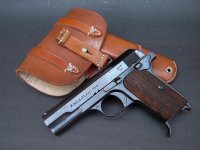Nope, I had nothing to do with the Wiki bit on the Type 14. It contained some minor errors, but was generally informative.
John
John-
I concur. I felt that it was unkind to the Type 14. Those that I've seen, other than very late examples, were well made. But the part about weak magazine springs may have been true even when the guns were new.
Douglas, Jr.-
Thanks! That holster looks pristine! I haven't seen that general style on any but postwar holsters for German police.
Can you post the photo of the pilot with the P-38, without copyright issues? Or, at least tell us if the P-38 holster was the hard type like the one for the P-08, or the breakaway later sort? It's quite possible that some Luftwaffe pilots preferred the greater power of the 9mm.
I've heard of all of the aces whom you named. How did the one with the HSc use it in the rescue mentioned? Surely, they didn't issue .32 flare ammo?! What can you add about his having a Mauser? Did he just mention a "Mauser" in his memoirs, or what?
The rescue part reminds me: All or most of the Colt M-1911 .455's left over from WW I were assigned to the RAF Air Rescue Service/ Coastal Command. (They had been RAF issue since the 1920's, anyway.) I'm sure that this was partly to get all of the .455 autos, which used a unique ammo, in one command. But the main reason why their flying boats had sidearms was that they also rescued German airmen down in the Channel. Had the crews not been armed, a German could draw his own pistol and commandeer the plane!
I think this was the only real use of the Colt .455's in WW II, although the Royal Navy used Webley .455 autos, as well as Webley .455 revolvers. I assume that at least some RN aircrewmen did use those guns.
The many Colt autos issued to Commando and SOE personnel were chambered in the usual .45ACP caliber. And they were buying them from 1940, well before the Lend-Lease Act.
I suspect that German aircrew carried pretty much what was available, including all of the various .32's issued in that era.
It would not amaze me to learn that many tried to get 9mm's in the North African theater. And some surely acquired Beretta .32's and .380s.
The Beretta M-34 was compact and at least as powerful as the British .38/200. I'm sure that the bullet penetrated better. The late David W. Arnold told me that he'd seen the metal-jacketed bullet from the latter fail to penetrate the British Army greatcoat in trials! (He carried a postwar P-38 when on anti-terrorist duty in Rhodesia. And he had considerable respect for the effectiveness of the 9mm in battle.)
If anyone can post photos of aircrew with sidearms, that'd be terrific, if no copyright issues arise. Most of those photos will be of uncertain copyright, anyway, and most were probably taken by military photographers. (Some by newsmen and "Life".)
There are well known ones of Dick Bong and his chief rival, Tom McGuire, wearing .45's in shoulder holsters, and Bong has his Randall knife in at least one of them. In, "War Pilot", Richard Kirkland mentioned his tentmate firing his .45 at bats or something, in New Guinea. I'd have to check the exact quote, but they obviously had .45 autos, plus whatever someone otherwise acquired. The guy may have just been cleaning it. (Jeff Cooper told me that he shot bats and traded them to natives for lobsters.)
War provided some odd examples. In the movie (yeah, I know: movies may not be authentic), "Never So Few", Steve McQueen's character had a Luger. I supposed when I first saw the movie as a high schooler that they used that because they couldn't get a Nambu 8mm. He supposedly got the gun from a dead Jap, I think.
Later, I found that the Japs re-issued many 9mm Lugers captured from the Dutch in the East Indies, now Indonesia. Some P-08's were probably private property of Dutch citizens there, too. So, although the movie maker likely didn't realize it, a Jap may well have been carrying a true Luger!
The movie, BTW, is one of the better WW II items, also starring Frank Sinatra, Peter Lawford, and other good actors. Some Italian actress played the female lead, who wound up with Sinatra's character, an OSS officer operating in Burma.
I think it was Gina Lollabridgeda (sp?)
This issue of airmens' pistols is a fascinating one, and one very hard to precisely define. Even with modern times and the US requirement that only official issue ones be worn, the matter remains cloudy. It does seem almost certain that Navy pilots have M-11's (SIG P-228's) and USAF has the M-9 Beretta...except sometimes!
T-Star


